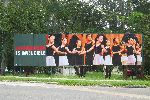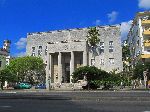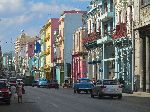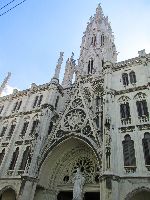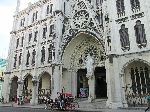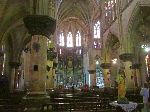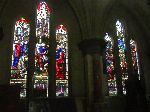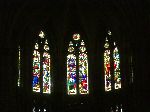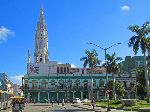| . | ||
Cuba
|
||
Havana (Central) |
||
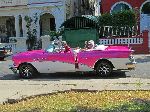 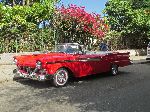 One
of the characteristics of Havana, that outsiders seem to be most aware of and
worried about, is its fleet of 1950's era automobile. There is nothing to
worry about. The market for vintage taxis is healthy and prospering. They
are such a solid revenue generator, that left to themselves, they are here
to stay, like horse drawn carriages in Central Park. If anything, there seem
to me more now than in 2000. Cubans are masters at keeping these vehicles on
the road and looking pretty. Could they be manufacturing them? One
of the characteristics of Havana, that outsiders seem to be most aware of and
worried about, is its fleet of 1950's era automobile. There is nothing to
worry about. The market for vintage taxis is healthy and prospering. They
are such a solid revenue generator, that left to themselves, they are here
to stay, like horse drawn carriages in Central Park. If anything, there seem
to me more now than in 2000. Cubans are masters at keeping these vehicles on
the road and looking pretty. Could they be manufacturing them? |
||
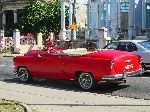
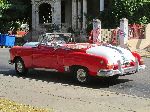
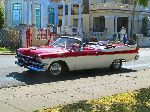
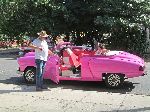
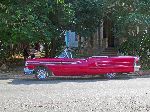 |
||
| This collection of ten pictures was taken at one location, in less than a ten-minute period. There is a wider spectrum of paint jobs, but there is a strong preference for candy-colors, and a bias for reds and pinks. And, on a sunny day, there are a lot of convertibles. | ||
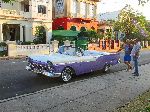
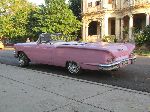
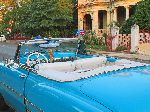
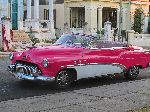
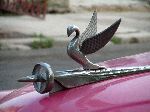 |
||
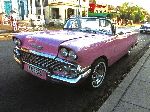 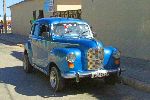 It
is probably no surprise that none of the cars have their original motors
after fifty years, but it is also interesting that for some of the cars the
chassis and bodies have different origins. It
is probably no surprise that none of the cars have their original motors
after fifty years, but it is also interesting that for some of the cars the
chassis and bodies have different origins.Not all of the old cars are 1950's American makes; a few are older, some originated in other parts of the world and then there are the bubble taxis and you can also choose to sightsee by horse drawn carriage and Pedicab. |
||
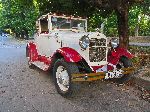
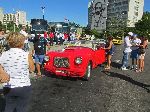
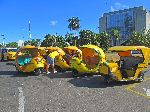
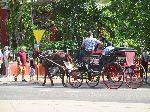
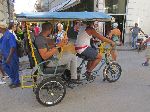 |
||
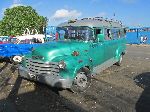 |
||
|
Central Havana
Nearby is another sign, of ballerinas, that reads, "the revolution is invincible." |
||
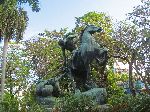 Near
the western side of Central Havana is "Los Portadores de la Antorcha",
a statue by American artist Anna Hyatt Huntington (1876-1973). It symbolizes
the passing of the torch of Western civilization from age to youth. There
are replicas of this work in bronze and aluminum, in Madrid and at least
four cities in the USA. Huntington was once among New York City's most
prominent sculptors, and created the statue of Jose Marti that is in NYC's
Central Park. Near
the western side of Central Havana is "Los Portadores de la Antorcha",
a statue by American artist Anna Hyatt Huntington (1876-1973). It symbolizes
the passing of the torch of Western civilization from age to youth. There
are replicas of this work in bronze and aluminum, in Madrid and at least
four cities in the USA. Huntington was once among New York City's most
prominent sculptors, and created the statue of Jose Marti that is in NYC's
Central Park. |
||
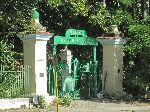 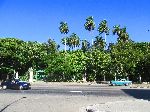 Quinta
de Los Molinos has a long history. Most famously it was the residence of the hero
General Máximo Gómez, and Botanical Garden of Havana. It gets it name from two
former mills (1800-1835), belonging to the King of Spain, that ground tobacco
into snuff. The areas use for plant collecting and research dates back to the
closing of the mills. In the mix of its current uses are a museum, programs for
vulnerable groups, nature trails, and environmental education programs and
demonstration projects. Quinta
de Los Molinos has a long history. Most famously it was the residence of the hero
General Máximo Gómez, and Botanical Garden of Havana. It gets it name from two
former mills (1800-1835), belonging to the King of Spain, that ground tobacco
into snuff. The areas use for plant collecting and research dates back to the
closing of the mills. In the mix of its current uses are a museum, programs for
vulnerable groups, nature trails, and environmental education programs and
demonstration projects. |
||
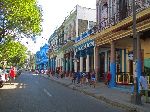
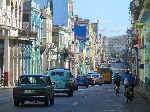
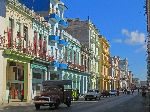
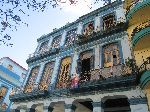
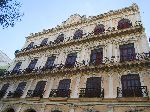 |
||
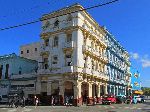
The inscription on the building to the right is "Sociedad económica de amigos
del Pais - MCMVLV" (Economic Society of But it is not all healthy. Amidst the eye candy there are shells of buildings where the interiors have crumbled and complete voids mid-block where entire buildings have disappeared. |
||
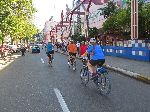 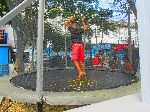 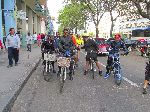 Tucked
in between the buildings is a children's play land with trampolines and other
activities. Tucked
in between the buildings is a children's play land with trampolines and other
activities.A new addition to Havana is bicycle police. The people have abandon bikes in the years after the special period. Maybe this will work legitimize them again. |
||
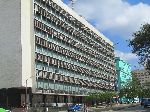 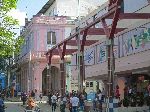 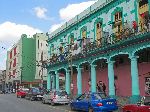 There
are a few 20th century modern building, but they aren't distinctive and tend to
interrupt the character of the city. Some of these have replaced crumbling
infrastructure, so the choice is between the look of urban dystopia or
architectural dissonance. There
are a few 20th century modern building, but they aren't distinctive and tend to
interrupt the character of the city. Some of these have replaced crumbling
infrastructure, so the choice is between the look of urban dystopia or
architectural dissonance.There is a huge need for economic incentive to hold the heritage together, and a match of financial resources to make it happen. Some of it is the preverbal race against time. |
||
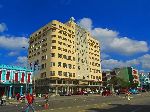 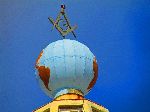 The
art-deco, Gran Templo Nacional Masónico de Cuba (Grand Lodge of Cuba) is
popularly known as the Masonic Building. It was built around 1955 to functions
as a temple and as the
headquarters of the Masonic bodies of Cuba. Cuban Freemasonry is unique in the
world for operating openly in a communist nation. Today, no less than 318
Masonic lodges flourish, openly attended by about 30,000 registered members.
Part of the attribution of the respect for Freemasonry in Cuba is is the role it
played during the three decades of struggle for independence from Spanish rule
between 1868 and 1895. The three great revolutionary leaders - José Martí,
Antonio Maceo and the "father of the nation" Carlos Manuel de Céspedes were all
Masons. It is also understood to have played a role (aiding and abetting) in the The
art-deco, Gran Templo Nacional Masónico de Cuba (Grand Lodge of Cuba) is
popularly known as the Masonic Building. It was built around 1955 to functions
as a temple and as the
headquarters of the Masonic bodies of Cuba. Cuban Freemasonry is unique in the
world for operating openly in a communist nation. Today, no less than 318
Masonic lodges flourish, openly attended by about 30,000 registered members.
Part of the attribution of the respect for Freemasonry in Cuba is is the role it
played during the three decades of struggle for independence from Spanish rule
between 1868 and 1895. The three great revolutionary leaders - José Martí,
Antonio Maceo and the "father of the nation" Carlos Manuel de Céspedes were all
Masons. It is also understood to have played a role (aiding and abetting) in the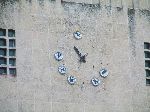 revolution of 1959, but its exact involvement is not settled. Not aligned with
the revolution, the vast majority of Cuban presidents, starting with Carlos
Manuel de Céspedes, were Masons. It may only be a coincidence, but the Masonic
Building is on Avenida Salvador Allende. Chilean Salvador Allende, friend and
ally of the Cuban Revolution, was a committed Mason. revolution of 1959, but its exact involvement is not settled. Not aligned with
the revolution, the vast majority of Cuban presidents, starting with Carlos
Manuel de Céspedes, were Masons. It may only be a coincidence, but the Masonic
Building is on Avenida Salvador Allende. Chilean Salvador Allende, friend and
ally of the Cuban Revolution, was a committed Mason.The clock above the entrance to the building has zodiac symbols at the hour points, though time has taken half of them. |
||
|
|
||
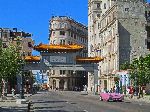 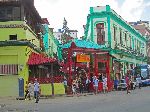 Havana's Chinatown
formed from the post-slavery rise of Chinese immigration in the 19th century
as contract laborers (i.e., indentured servants) in agricultural industries.
After completing 8-year contracts, many of these workers settled permanently in
Cuba, where their descendants have since intermarried with non-Chinese Cubans.
Most came from Guangdong Province, Hong Kong, Macau and Taiwan. After the Cuban
Revolution, many Chinese Cuban entrepreneurs fled the country for the United
States. Chinatown in Havana now mainly serve as tourist attractions and not as
true, living ethnic community. Cuba's Chinese population is largely
multi-generation Spanish-speaking Chinese. To tie in with the Revolution's
economic reliance on tourism, attempts have recently been launched to attract
revitalization investment for the Chinatown. After the major official visit by
Fidel Castro to the People's Republic of China in 1995, materials were given for
the new Chinese arch on Calle Dragone. Havana's Chinatown
formed from the post-slavery rise of Chinese immigration in the 19th century
as contract laborers (i.e., indentured servants) in agricultural industries.
After completing 8-year contracts, many of these workers settled permanently in
Cuba, where their descendants have since intermarried with non-Chinese Cubans.
Most came from Guangdong Province, Hong Kong, Macau and Taiwan. After the Cuban
Revolution, many Chinese Cuban entrepreneurs fled the country for the United
States. Chinatown in Havana now mainly serve as tourist attractions and not as
true, living ethnic community. Cuba's Chinese population is largely
multi-generation Spanish-speaking Chinese. To tie in with the Revolution's
economic reliance on tourism, attempts have recently been launched to attract
revitalization investment for the Chinatown. After the major official visit by
Fidel Castro to the People's Republic of China in 1995, materials were given for
the new Chinese arch on Calle Dragone. |
||
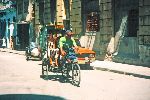 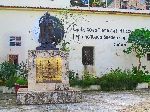
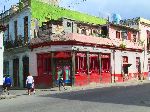
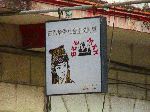
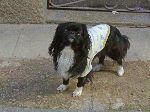 |
||
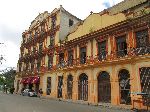 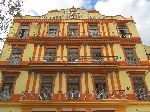 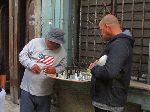 Just
outside of Chinatown is Partagás, Havana's most famous cigar factory. It was
built in 1845, and is one of three cigar factories in Havana that are open
to tourists. When the cruise ships are in port, all of them can have lines. Just
outside of Chinatown is Partagás, Havana's most famous cigar factory. It was
built in 1845, and is one of three cigar factories in Havana that are open
to tourists. When the cruise ships are in port, all of them can have lines.A couple of Cubans play chess on a board cantilevered out a window (right). The American flag decorated shirt has become common place with the Raul administration. |
||
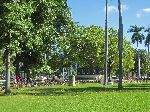 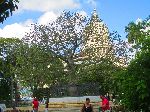 Parque
de la Fraternidad (Fraternity
Park) commemorates a conference of the friendship between the countries of the Americas. The
park is built on former 18th-century military training grounds called the Fields
of Martyrs. After 1928 it was transformed into the American Fraternity Park
during the Pan-American Congress held in the city that same year. During the
congress a ceiba tree (Bombacoideae) was planted in the center of the park using
dirt from all the countries of the American Continent. Parque
de la Fraternidad (Fraternity
Park) commemorates a conference of the friendship between the countries of the Americas. The
park is built on former 18th-century military training grounds called the Fields
of Martyrs. After 1928 it was transformed into the American Fraternity Park
during the Pan-American Congress held in the city that same year. During the
congress a ceiba tree (Bombacoideae) was planted in the center of the park using
dirt from all the countries of the American Continent. |
||
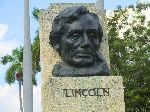
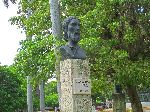
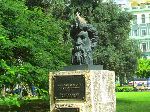
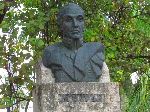
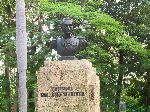 |
||
| Around the perimeter are monuments to a dozen famous men (above, left to right): Abraham Lincoln, Tiradentes - Joaquin Jose da Silva Xavier, Ramon Emeterio Betances (Puerto Rico), Simon Bolivar, and Gen. Jose de San Martin | ||
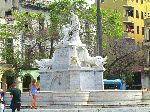 Across
the street is Fuente de la India or la Noble Habana,
designed by Italian architect Giuseppe
Gaggini. It is made of white Carrara marble, and was brought from Italy
in 1837. It is a representation of the mythical Indian woman called Habana,
the wife of cacique Habaguanex who ruled in the area before the arrival of
Columbus. The Indian woman sits on a pedestal surrounded by four dolphins, which
stream water that falls on huge shells. She is adorned with a crown of feathers,
while on her left hand she holds a cornucopia of Cuban fruits. On her right
hand, she holds an oval shield bearing the city’s coat of arms. Across
the street is Fuente de la India or la Noble Habana,
designed by Italian architect Giuseppe
Gaggini. It is made of white Carrara marble, and was brought from Italy
in 1837. It is a representation of the mythical Indian woman called Habana,
the wife of cacique Habaguanex who ruled in the area before the arrival of
Columbus. The Indian woman sits on a pedestal surrounded by four dolphins, which
stream water that falls on huge shells. She is adorned with a crown of feathers,
while on her left hand she holds a cornucopia of Cuban fruits. On her right
hand, she holds an oval shield bearing the city’s coat of arms. |
||
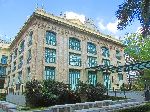 Teatro
Marti is a Romanesque-style theater opened in 1884 as Teatro Irijoa. Its name
was changed in 1900. The interior is simple and elegant, and it has great
acoustics. In 1902, the theater hosted the heated debates over the Platt
Amendment, which stipulated the conditions for the US's withdrawal from Cuba -
not making it a US colony. Many Cuban zarzuelas (musical comedies that
preceded cabarets) premiered here and it became home to “teatro bufo”–satirical
plays, many of which often mocked the Spanish authorities. After several decades
in dereliction, it was extensively and painstakingly renovated, and
technologically brought up to date by the City Historian’s Office. It reopened
in 2014. Teatro
Marti is a Romanesque-style theater opened in 1884 as Teatro Irijoa. Its name
was changed in 1900. The interior is simple and elegant, and it has great
acoustics. In 1902, the theater hosted the heated debates over the Platt
Amendment, which stipulated the conditions for the US's withdrawal from Cuba -
not making it a US colony. Many Cuban zarzuelas (musical comedies that
preceded cabarets) premiered here and it became home to “teatro bufo”–satirical
plays, many of which often mocked the Spanish authorities. After several decades
in dereliction, it was extensively and painstakingly renovated, and
technologically brought up to date by the City Historian’s Office. It reopened
in 2014. |
||
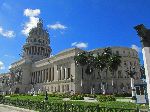 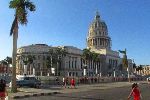 El
Capitolio (National Capitol Building) was the USA capitol inspired seat of government until after the
Cuban Revolution in 1959. The building has been repurposed as the home of the
Cuban Academy of Sciences, of the Ministry of Science, Technology and the
Environment. The Capitol has been under renovation and restoration since
2013, to once again serve as the home of the Cuban National Assembly. El
Capitolio (National Capitol Building) was the USA capitol inspired seat of government until after the
Cuban Revolution in 1959. The building has been repurposed as the home of the
Cuban Academy of Sciences, of the Ministry of Science, Technology and the
Environment. The Capitol has been under renovation and restoration since
2013, to once again serve as the home of the Cuban National Assembly.
Over the last few decades, the Cuban Academy has worked with the U.S. Smithsonian Institution on scientific exchanges despite frayed political relations between the two nations. |
||
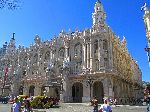
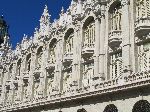 Facing
the Capitol and Central Park is the Gran Teatro de la Habana.
This ornate and palatial theater built was 1838. It was constructed to serve as
a social center for Galician immigrants to Havana. The building is decorated
with a stone and marble statue as well as sculptures by Giuseppe Moretti,
representing allegories depicting benevolence, education, music and theatre. Its grand
main hall is now home to the Cuban National Ballet. It facilities include
theatres, a concert hall, conference rooms, and a video screening room, as well
as an art gallery, a choral center and several rehearsal halls for danzarias
groups and dance companies. Facing
the Capitol and Central Park is the Gran Teatro de la Habana.
This ornate and palatial theater built was 1838. It was constructed to serve as
a social center for Galician immigrants to Havana. The building is decorated
with a stone and marble statue as well as sculptures by Giuseppe Moretti,
representing allegories depicting benevolence, education, music and theatre. Its grand
main hall is now home to the Cuban National Ballet. It facilities include
theatres, a concert hall, conference rooms, and a video screening room, as well
as an art gallery, a choral center and several rehearsal halls for danzarias
groups and dance companies. |
||
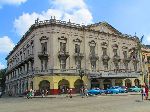 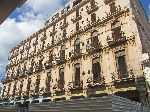 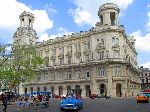 On the opposite side of Central Park is the Museo
de Bellas Artes (right), a cavernous, multilevel cultural museum with a vast
collection of works by Cuban & other artists. Between the two is the Teatro
Payret (left), the largest cinema in Cuba. It was rebuilt in 1951. On the opposite side of Central Park is the Museo
de Bellas Artes (right), a cavernous, multilevel cultural museum with a vast
collection of works by Cuban & other artists. Between the two is the Teatro
Payret (left), the largest cinema in Cuba. It was rebuilt in 1951. |
||
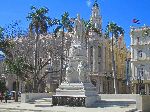 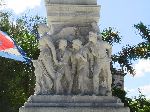 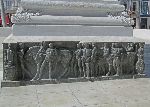 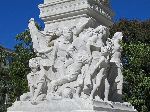 The center piece of Central Park is a statue of José Marti, by José Vilalta de
Saavedra (1905). This was the first statue of José Marti in Cuba. During a
survey of 105 prominent citizens of the time, only 16 selected Marti, but in a
process, that included sixteen-plus names, that was sufficient to carry the day.
Each level of the plinth is
surrounded by additional sculpture. For those who like trivia, there is a statue
of José Marti (on horseback), in Central Park, New York City. The center piece of Central Park is a statue of José Marti, by José Vilalta de
Saavedra (1905). This was the first statue of José Marti in Cuba. During a
survey of 105 prominent citizens of the time, only 16 selected Marti, but in a
process, that included sixteen-plus names, that was sufficient to carry the day.
Each level of the plinth is
surrounded by additional sculpture. For those who like trivia, there is a statue
of José Marti (on horseback), in Central Park, New York City. |
||
|
|
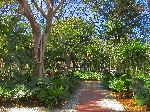 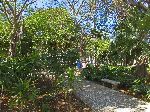 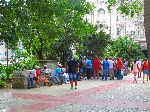 Central
Park is surround by hotels and vintage car, ready to take tourists on tours of
the city are parked nearby, but it is local Cubans who mostly go into the park
and sit down, read newspapers, converse, and enjoy it. Tourism sort of swirls around it. Central
Park is surround by hotels and vintage car, ready to take tourists on tours of
the city are parked nearby, but it is local Cubans who mostly go into the park
and sit down, read newspapers, converse, and enjoy it. Tourism sort of swirls around it.
In one court, squina caliente (hot corner), important baseball games are projected and regular games are monitored by radio. If you hadn't heard, many Cuban are very passionate about baseball and have strong team allegiances. This can make for very animated audiences. Even out of season they talk baseball here, and rehash past games with almost the same level zeal. |
|
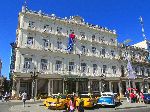
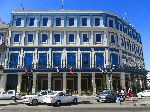
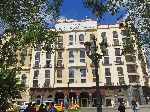
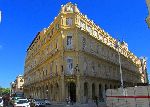
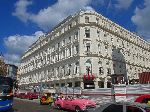 The park is in a cluster of nicely restored buildings and building currently under restoration. In addition to the afore mentioned theatre and museum, at the north end there is the Hotel Inglaterra, Hotel Telegrafo, Iberostar Parque Central, Hotel Plaza, and Manzana de Gomez (a former 1910 shopping arcade that is being converted to a hotel). |
||
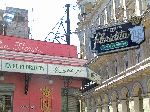 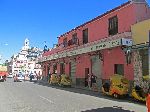 The Floridita
is a fish restaurant, that is famous for its daiquiris, and even more famous
because Earnest Hemingway hung out there, but not to eat fish dinners. A
restaurant first opened on this corner in 1817, as "La Piña
de Plata.". It acquired its current name in the early 20th century. Among the
other foreign intellectuals and artist who frequented the Floridita were Ezra
Pound, John Dos Passos, and Graham Greene. The Floridita
is a fish restaurant, that is famous for its daiquiris, and even more famous
because Earnest Hemingway hung out there, but not to eat fish dinners. A
restaurant first opened on this corner in 1817, as "La Piña
de Plata.". It acquired its current name in the early 20th century. Among the
other foreign intellectuals and artist who frequented the Floridita were Ezra
Pound, John Dos Passos, and Graham Greene. |
||
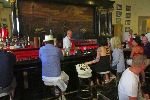
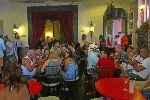
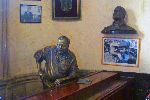 The Floridita is now very popular with tourist and a bronze statue of Hemingway hangs out is a corner shrine for him. Tourist file in and take their pictures with the bard and file out again. A few linger for a drink. |
||
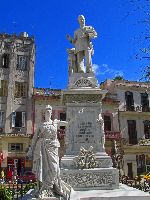 A statue of Cuban engineer, Francisco de Albear y Lara (left), by José Vilalta de Saavedra, stands in the epitomes named park across from the Floridita. Albear eventually he reached the rank of Brigadier General of the Royal Corps of Engineers, being in charge of over 182 projects in Cuba. He also was involved in scientific research, and was member of various scientific institutions among them; the Royal Academy of Sciences of Madrid, the Royal Geographic Society of Spain, the Scientific Society of Brussels, the Royal Economic Society of the Friends of the Country of Havana, and the Royal Academy of Medical, Physical and Natural Sciences of Havana. His main achievement was the 19th century water supply for Havana, now known as Acueducto de Albear. It took 32 years to construct, largely due to lack of funds. |
||
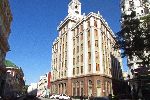
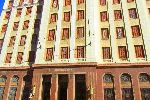 Bacardi
Building is an Art Deco building, completed in 1930, and was at the time the
largest building in the city. It was designed by architects Rafael Fernández
Ruenes, Esteban Rodríguez Castell and José Menéndez. At the end of the 1990s it
was renovated by the city historian's office. Bacardi
Building is an Art Deco building, completed in 1930, and was at the time the
largest building in the city. It was designed by architects Rafael Fernández
Ruenes, Esteban Rodríguez Castell and José Menéndez. At the end of the 1990s it
was renovated by the city historian's office. |
||
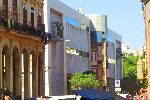
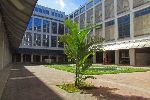
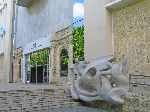
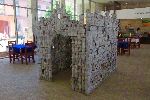
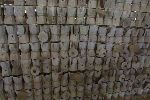 |
||
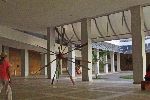 Museo Nacional de Bellas Artes de La Habana (National Museum of Fine Arts of
Havana) collects works of Cuban artists. The permanent exhibit shows pieces
from colonial times up until about 1996, when additions to the exhibit seem
to have stopped. There are a couple of large, newer, installations on the
ground floor. Museo Nacional de Bellas Artes de La Habana (National Museum of Fine Arts of
Havana) collects works of Cuban artists. The permanent exhibit shows pieces
from colonial times up until about 1996, when additions to the exhibit seem
to have stopped. There are a couple of large, newer, installations on the
ground floor. |
||
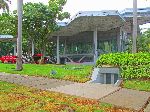 Here
rest the Gramma, the boat Fidel and his comrade took from Mexico to eastern
Cuba, to begin the active Revolution. The Gramma Memorial is part of the Museum
of the Revolution. Here
rest the Gramma, the boat Fidel and his comrade took from Mexico to eastern
Cuba, to begin the active Revolution. The Gramma Memorial is part of the Museum
of the Revolution. |
||
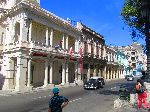
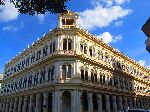
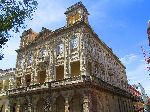
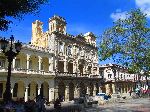
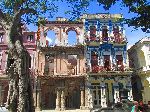 |
||
| This series of ornate building was take over a few blocks along Paseo del Prado. It is engrossing to sit and marvel at the amount of detail on some of the buildings. | ||
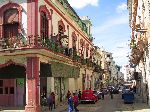
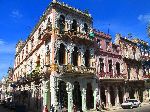
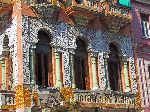
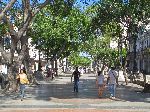
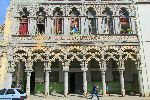 |
||
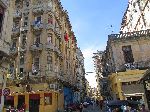 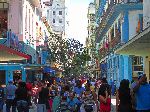 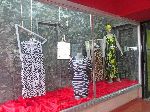 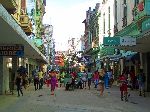 For
a half dozen blocks off of Paseo del Prado,
San Rafel street is pedestrian only. It has a variety of retail stores,
restaurants and entertainment venues that had the street full of people by
mid-morning. For
a half dozen blocks off of Paseo del Prado,
San Rafel street is pedestrian only. It has a variety of retail stores,
restaurants and entertainment venues that had the street full of people by
mid-morning. |
||
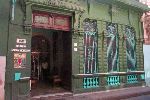 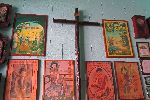 The
business on San Rafel with the broadest reputation is probably Paladar San
Cristobal. It only opened in about 2010, but from the decor and ambiance you
would think that it has its roots about 60 years earlier. Like a true paladar,
the owner and chef lives in the building - upstairs. It already had a top rating
in 2016, when President and Michele Obama visited Havana and dined there. The
service and food deserves every bit of its reputation. The
business on San Rafel with the broadest reputation is probably Paladar San
Cristobal. It only opened in about 2010, but from the decor and ambiance you
would think that it has its roots about 60 years earlier. Like a true paladar,
the owner and chef lives in the building - upstairs. It already had a top rating
in 2016, when President and Michele Obama visited Havana and dined there. The
service and food deserves every bit of its reputation. |
||
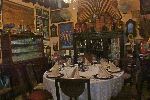
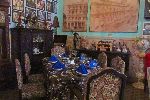
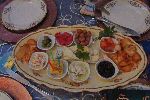
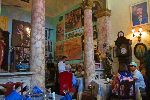
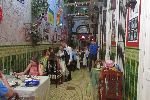 |
||
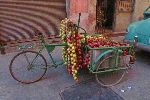
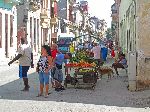
 To
the west San Rafel is more like other streets in the neighborhood. It is narrow
and open to traffic, though there isn't much. Spaced along the road there are
various vendors and a few factories. To
the west San Rafel is more like other streets in the neighborhood. It is narrow
and open to traffic, though there isn't much. Spaced along the road there are
various vendors and a few factories. |
||
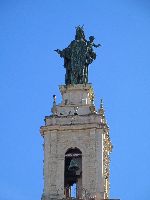 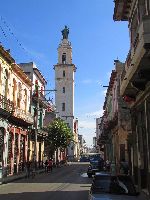 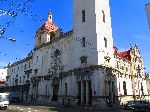 Iglesia y Convento de Nuestra Señora del Carmen lies near the western side of Central Havana. The church was only built in 1923-27 to house the Carmelite order. The interior is one of the finest in Cuba. |
||
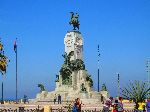 Down
the street, at the Malecon, is a major monument to Lt. General José Antonio de
la Caridad Maceo y Grajales (1845 – 1896). He was second-in-command of the Cuban
Army of Independence. Fellow Cubans gave Maceo the sobriquet of the "Bronze
Titan" (Spanish: El Titan de Bronce),
which was a reference to his skin color, stature and status. Spaniards referred
to Maceo as the "Greater Lion" (El Leon mayor). Maceo was one of the most
noteworthy guerrilla leaders in 19th century Latin America, comparable to José
Antonio Páez of Venezuela in military acumen. Maceo was killed when he and a
small band of soldiers were ambushed by the Spanish, during the Cuban
Independence Way, as they were making preparations for later troop movements
south of Havana. Cuba got its independence with the fall of the Spanish three
years later. Down
the street, at the Malecon, is a major monument to Lt. General José Antonio de
la Caridad Maceo y Grajales (1845 – 1896). He was second-in-command of the Cuban
Army of Independence. Fellow Cubans gave Maceo the sobriquet of the "Bronze
Titan" (Spanish: El Titan de Bronce),
which was a reference to his skin color, stature and status. Spaniards referred
to Maceo as the "Greater Lion" (El Leon mayor). Maceo was one of the most
noteworthy guerrilla leaders in 19th century Latin America, comparable to José
Antonio Páez of Venezuela in military acumen. Maceo was killed when he and a
small band of soldiers were ambushed by the Spanish, during the Cuban
Independence Way, as they were making preparations for later troop movements
south of Havana. Cuba got its independence with the fall of the Spanish three
years later. |
||
| Historical Notes (1998): | ||
| On our way into town we visited the Velodrome and visited the shop of the national bike racing team. A lot of private individuals in the U.S. have more tools and spares in their home workshop than the national team's mechanics have. | ||
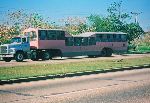 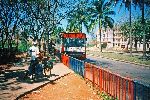 By
North American standards, traffic in Havana is light. Lots of people on the roadside waiting for
buses. The Cubans have developed a bus, pulled by a truck cab that can hold 200 people.
Because it has two humps it is called a "camel bus." They also have a bus where
all of the seats have been remove for transporting bikes and riders through the tunnel
under the channel into Havana harbor. This is called the "ciclobus." By
North American standards, traffic in Havana is light. Lots of people on the roadside waiting for
buses. The Cubans have developed a bus, pulled by a truck cab that can hold 200 people.
Because it has two humps it is called a "camel bus." They also have a bus where
all of the seats have been remove for transporting bikes and riders through the tunnel
under the channel into Havana harbor. This is called the "ciclobus." |
||
| We had a bike to donate. Iit was suggested that we consider giving it to the outreach program of the Community Mental Health Clinic of La Regula. To get to Regula you need to take a boat across Havana harbor. Again, the transport was well designed for handling bicycles. We rolled our bikes on and rolled them off and then is was just a short ride up the street to the clinic. | ||
| Through a contact, a couple of us had a chance to visit Radio Havana. Part of the story is how normal it is: they do programming on news, sports and entertainment and broadcast in a half-dozen languages (Spanish, English, French, Arabic, Creole, Esperanto). Prior to the collapse of the Soviet Union, their signal was relayed around the world. Now their reach is not so far. The Pope’s visit was the most exciting recent event and kept them all very busy for a weeks | ||
| One of my last visit was to Humberto Valdes-Rios, one of the senior planners for Cuba transportation plan. The gist of conversation is that, even after the end of special period, bikes are still a priority and a number of new programs are being developed to reinforce that. A more extensive report on this topic is on the International Bicycle Fund’s Web site at www.ibike.org. | ||
| For the evening, we again stay in a private apartments, which gave us the chance to talk with our hosts. As throughout the visit, people-to-people discussions have provided some of the most interesting insights into the Cuban. It reinforced that Fidel still maintain tremendous support from the Cuban people. He is highly respected for what he has done for education, health care and changes in the society. People also feel free to discuss the pros and cons of Fidel’s economic and foreign policy – with the windows to the street wide open. | ||
|
Vedado |
||
    |
||
|
"Hosted by
DreamHost - earth friendly web hosting"
|
||
|
|
|

